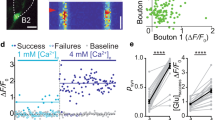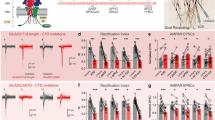Abstract
At many excitatory and inhibitory synapses throughout the nervous system, postsynaptic currents become faster as the synapse matures, primarily owing to changes in receptor subunit composition. The origin of the developmental acceleration of AMPA receptor (AMPAR)-mediated excitatory postsynaptic currents (EPSCs) remains elusive. We used patch-clamp recordings, electron microscopic immunogold localization of AMPARs, partial three-dimensional reconstruction of the neuropil and numerical simulations of glutamate diffusion and AMPAR activation to examine the factors underlying the developmental speeding of miniature EPSCs in mouse cerebellar granule cells. We found that the main developmental change that permits submillisecond transmission at mature synapses is an alteration in the glutamate concentration waveform as experienced by AMPARs. This can be accounted for by changes in the synaptic structure and surrounding neuropil, rather than by a change in AMPAR properties. Our findings raise the possibility that structural alterations could be a general mechanism underlying the change in the time course of AMPAR-mediated synaptic transmission.
This is a preview of subscription content, access via your institution
Access options
Subscribe to this journal
Receive 12 print issues and online access
$209.00 per year
only $17.42 per issue
Buy this article
- Purchase on Springer Link
- Instant access to full article PDF
Prices may be subject to local taxes which are calculated during checkout








Similar content being viewed by others
References
Mishina, M. et al. Molecular distinction between fetal and adult forms of muscle acetylcholine receptor. Nature 321, 406–411 (1986).
Takahashi, T., Momiyama, A., Hirai, K., Hishinuma, F. & Akagi, H. Functional correlation of fetal and adult forms of glycine receptors with developmental changes in inhibitory synaptic receptor channels. Neuron 9, 1155–1161 (1992).
Tia, S., Wang, J.F., Kotchabhakdi, N. & Vicini, S. Developmental changes of inhibitory synaptic currents in cerebellar granule neurons: role of GABAA receptor alpha 6 subunit. J. Neurosci. 16, 3630–3640 (1996).
Hestrin, S. Developmental regulation of NMDA receptor-mediated synaptic currents at a central synapse. Nature 357, 686–689 (1992).
Bellingham, M.C., Lim, R. & Walmsley, B. Developmental changes in EPSC quantal size and quantal content at a central glutamatergic synapse in rat. J. Physiol. (Lond.) 511, 861–869 (1998).
Taschenberger, H. & von Gersdorff, H. Fine-tuning an auditory synapse for speed and fidelity: developmental changes in presynaptic waveform, EPSC kinetics, and synaptic plasticity. J. Neurosci. 20, 9162–9173 (2000).
Wall, M.J., Robert, A., Howe, J.R. & Usowicz, M.M. The speeding of EPSC kinetics during maturation of a central synapse. Eur. J. Neurosci. 15, 785–797 (2002).
London, M., Schreibman, A., Hausser, M., Larkum, M.E. & Segev, I. The information efficacy of a synapse. Nat. Neurosci. 5, 332–340 (2002).
Lawrence, J.J. & Trussell, L.O. Long-term specification of AMPA receptor properties after synapse formation. J. Neurosci. 20, 4864–4870 (2000).
Kumar, S.S., Bacci, A., Kharazia, V. & Huguenard, J.R. A developmental switch of AMPA receptor subunits in neocortical pyramidal neurons. J. Neurosci. 22, 3005–3015 (2002).
Liu, S.Q. & Cull-Candy, S.G. Synaptic activity at calcium-permeable AMPA receptors induces a switch in receptor subtype. Nature 405, 454–458 (2000).
Benke, T.A., Luthi, A., Isaac, J.T. & Collingridge, G.L. Modulation of AMPA receptor unitary conductance by synaptic activity. Nature 393, 793–797 (1998).
Jonas, P. The time course of signaling at central glutamatergic synapses. News Physiol. Sci. 15, 83–89 (2000).
Cathala, L., Brickley, S., Cull-Candy, S. & Farrant, M. Maturation of EPSCs and intrinsic membrane properties enhances precision at a cerebellar synapse. J. Neurosci. 23, 6074–6085 (2003).
Monyer, H., Seeburg, P.H. & Wisden, W. Glutamate-operated channels: developmentally early and mature forms arise by alternative splicing. Neuron 6, 799–810 (1991).
Mosbacher, J. et al. A molecular determinant for submillisecond desensitization in glutamate receptors. Science 266, 1059–1062 (1994).
Silver, R.A., Cull-Candy, S.G. & Takahashi, T. Non-NMDA glutamate receptor occupancy and open probability at a rat cerebellar synapse with single and multiple release sites. J. Physiol. (Lond.) 494, 231–250 (1996).
DiGregorio, D.A., Nusser, Z. & Silver, R.A. Spillover of glutamate onto synaptic AMPA receptors enhances fast transmission at a cerebellar synapse. Neuron 35, 521–533 (2002).
Xu-Friedman, M.A., Harris, K.M. & Regehr, W.G. Three-dimensional comparison of ultrastructural characteristics at depressing and facilitating synapses onto cerebellar Purkinje cells. J. Neurosci. 21, 6666–6672 (2001).
Silver, R.A., Colquhoun, D., Cull-Candy, S.G. & Edmonds, B. Deactivation and desensitization of non-NMDA receptors in patches and the time course of EPSCs in rat cerebellar granule cells. J. Physiol. (Lond.) 493, 167–173 (1996).
Smith, T.C., Wang, L.Y. & Howe, J.R. Heterogeneous conductance levels of native AMPA receptors. J. Neurosci. 20, 2073–2085 (2000).
Swanson, G.T., Kamboj, S.K. & Cull-Candy, S.G. Single-channel properties of recombinant AMPA receptors depend on RNA editing, splice variation, and subunit composition. J. Neurosci. 17, 58–69 (1997).
Otis, T.S., Wu, Y.C. & Trussell, L.O. Delayed clearance of transmitter and the role of glutamate transporters at synapses with multiple release sites. J. Neurosci. 16, 1634–1644 (1996).
Mansour, M., Nagarajan, N., Nehring, R.B., Clements, J.D. & Rosenmund, C. Heteromeric AMPA receptors assemble with a preferred subunit stoichiometry and spatial arrangement. Neuron 32, 841–853 (2001).
Brorson, J.R., Li, D. & Suzuki, T. Selective expression of heteromeric AMPA receptors driven by flip-flop differences. J. Neurosci. 24, 3461–3470 (2004).
Koike, M., Tsukada, S., Tsuzuki, K., Kijima, H. & Ozawa, S. Regulation of kinetic properties of GluR2 AMPA receptor channels by alternative splicing. J. Neurosci. 20, 2166–2174 (2000).
Partin, K.M., Patneau, D.K. & Mayer, M.L. Cyclothiazide differentially modulates desensitization of alpha-amino-3-hydroxy-5-methyl-4-isoxazolepropionic acid receptor splice variants. Mol. Pharmacol. 46, 129–138 (1994).
Diamond, J.S. & Jahr, C.E. Asynchronous release of synaptic vesicles determines the time course of the AMPA receptor-mediated EPSC. Neuron 15, 1097–1107 (1995).
Diamond, J.S. & Jahr, C.E. Transporters buffer synaptically released glutamate on a submillisecond time scale. J. Neurosci. 17, 4672–4687 (1997).
Yamashita, T., Ishikawa, T. & Takahashi, T. Developmental increase in vesicular glutamate content does not cause saturation of AMPA receptors at the calyx of held synapse. J. Neurosci. 23, 3633–3638 (2003).
Nusser, Z. et al. Cell type and pathway dependence of synaptic AMPA receptor number and variability in the hippocampus. Neuron 21, 545–559 (1998).
Tanaka, J. et al. Number and density of AMPA receptors in single synapses in immature cerebellum. J. Neurosci. 25, 799–807 (2005).
Hamori, J. & Somogyi, J. Differentiation of cerebellar mossy fiber synapses in the rat: a quantitative electron microscope study. J. Comp. Neurol. 220, 365–377 (1983).
Jakab, R.L. & Hamori, J. Quantitative morphology and synaptology of cerebellar glomeruli in the rat. Anat. Embryol. (Berl.) 179, 81–88 (1988).
Nielsen, T.A., DiGregorio, D.A. & Silver, R.A. Modulation of glutamate mobility reveals the mechanism underlying slow-rising AMPAR EPSCs and the diffusion coefficient in the synaptic cleft. Neuron 42, 757–771 (2004).
Hausser, M. & Roth, A. Dendritic and somatic glutamate receptor channels in rat cerebellar Purkinje cells. J. Physiol. (Lond.) 501, 77–95 (1997).
Franks, K.M., Bartol, T.M., Jr . & Sejnowski, T.J. A Monte Carlo model reveals independent signaling at central glutamatergic synapses. Biophys. J. 83, 2333–2348 (2002).
Rusakov, D.A. The role of perisynaptic glial sheaths in glutamate spillover and extracellular Ca2+ depletion. Biophys. J. 81, 1947–1959 (2001).
Barbour, B. An evaluation of synapse independence. J. Neurosci. 21, 7969–7984 (2001).
Xu-Friedman, M.A. & Regehr, W.G. Ultrastructural contributions to desensitization at cerebellar mossy fiber to granule cell synapses. J. Neurosci. 23, 2182–2192 (2003).
Partin, K.M., Fleck, M.W. & Mayer, M.L. AMPA receptor flip/flop mutants affecting deactivation, desensitization, and modulation by cyclothiazide, aniracetam, and thiocyanate. J. Neurosci. 16, 6634–6647 (1996).
Raman, I.M. & Trussell, L.O. The mechanism of alpha-amino-3-hydroxy-5-methyl-4-isoxazolepropionate receptor desensitization after removal of glutamate. Biophys. J. 68, 137–146 (1995).
Saftenku, E.E. Modeling of slow glutamate diffusion and AMPA receptor activation in the cerebellar glomerulus. J. Theor. Biol. 234, 363–382 (2005).
Renger, J.J., Egles, C. & Liu, G. A developmental switch in neurotransmitter flux enhances synaptic efficacy by affecting AMPA receptor activation. Neuron 29, 469–484 (2001).
Murphy, T.H. et al. Differential regulation of calcium/calmodulin-dependent protein kinase II and p42 MAP kinase activity by synaptic transmission. J. Neurosci. 14, 1320–1331 (1994).
McKinney, R.A., Capogna, M., Durr, R., Gahwiler, B.H. & Thompson, S.M. Miniature synaptic events maintain dendritic spines via AMPA receptor activation. Nat. Neurosci. 2, 44–49 (1999).
Walmsley, B., Alvarez, F.J. & Fyffe, R.E. Diversity of structure and function at mammalian central synapses. Trends Neurosci. 21, 81–88 (1998).
Koike-Tani, M., Saitoh, N. & Takahashi, T. Mechanisms underlying developmental speeding in AMPA-EPSC decay time at the calyx of Held. J. Neurosci. 25, 199–207 (2005).
Taschenberger, H., Leao, R.M., Rowland, K.C., Spirou, G.A. & von Gersdorff, H. Optimizing synaptic architecture and efficiency for high-frequency transmission. Neuron 36, 1127–1143 (2002).
Segal, M. Dendritic spines and long-term plasticity. Nat. Rev. Neurosci. 6, 277–284 (2005).
Acknowledgements
This work was supported by a Wellcome Trust Programme Grant (S.G.C.-C.), a Wellcome Trust Travelling Fellowship (L.C.) and the Centre National de la Recherche Scientifique (L.C. and D.A.D.). S.G.C.-C. holds a Royal Society-Wolfson Award. Z.N. acknowledges receipt of a Wellcome Trust International Senior Research Fellowship, an International Scholarship from Howard Hughes Medical Institute and a Postdoctoral Fellowship from the Boehringer Ingelheim Fund. We thank E. Molnár for providing the anti-pan-AMPA antibody and M. Köllö for his help with the 3D reconstruction. We thank T. Nielsen and J. Rothman for provision of software, S. Brickley, M. Farrant, V. Nägerl and A. Silver for helpful discussions, and B. Barbour, P. DiGregorio, M. Farrant, A. Marty, T. Nielsen, A. Silver and A. Roth for comments on the manuscript.
Author information
Authors and Affiliations
Corresponding author
Ethics declarations
Competing interests
The authors declare no competing financial interests.
Supplementary information
Rights and permissions
About this article
Cite this article
Cathala, L., Holderith, N., Nusser, Z. et al. Changes in synaptic structure underlie the developmental speeding of AMPA receptor–mediated EPSCs. Nat Neurosci 8, 1310–1318 (2005). https://doi.org/10.1038/nn1534
Received:
Accepted:
Published:
Issue Date:
DOI: https://doi.org/10.1038/nn1534
This article is cited by
-
Homomeric GluA2(R) AMPA receptors can conduct when desensitized
Nature Communications (2019)
-
GSG1L suppresses AMPA receptor-mediated synaptic transmission and uniquely modulates AMPA receptor kinetics in hippocampal neurons
Nature Communications (2016)
-
Cntnap4 differentially contributes to GABAergic and dopaminergic synaptic transmission
Nature (2014)
-
Central synapses release a resource-efficient amount of glutamate
Nature Neuroscience (2013)
-
TARP γ-7 selectively enhances synaptic expression of calcium-permeable AMPARs
Nature Neuroscience (2013)



